How to Make â€å“brownã¢â‚¬â Beef Bone Stock
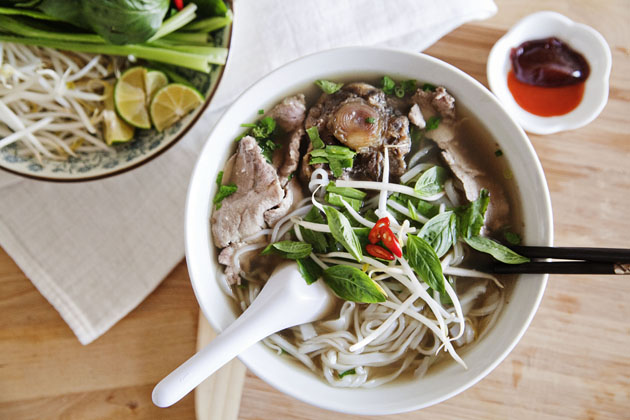
I’m not sure when exactly it became cool to eat pho — that iconic Vietnamese dish of thin rice noodles in beef broth perfumed with spices. Nowadays, you’d be hard-pressed to walk down the street without running into a pho restaurant with either a double digit or a bad pun in its name. The pho craze has gotten so big that it's resulted in pho food trucks, dating sites in lagrange ga, http://www.meatlovessalt.com/marriage-without-dating-cast/ maxie and johnny dating in real life whats it like dating a marine, and specialty pho places that serve it with things like http://www.meatlovessalt.com/best-first-dating-questions/, filet mignon, ox penis, or — what might even be strangest of all — broccoli and quinoa. :) You can find it at Vegas buffets, at summer camps, school cafeterias, even in rap songs!
Growing up in suburban Phoenix, Arizona, pho was as much a part of my childhood as Kraft macaroni and cheese. But sadly it was often the latter that I requested when friends from school had dinner with us. As an awkward teenager just trying to fit in, I specifically asked my mom one time to make Kraft macaroni and cheese when a friend came over, just to make sure nothing strange would be on the menu that night, like tripe or pigs' feet. After that time, my mom would automatically get the blue box out whenever a friend stayed for dinner.
When it was just us, though, it wasn’t uncommon for my dad to cook up a pot of pho for a weeknight family dinner, a dinner party with friends, or even for our entire Asian church congregation. In our home, cooking pho was both an elaborate ritual and yet second-nature to us all. It was a two-day affair, and we each knew our roles by heart. In the evening, Dad charred the ginger and onions over an open flame on the stove, filling our home with the sweet, smoky aroma. As the soup cooked overnight, Mom got up from bed every few hours to tend lovingly to the broth, making sure it always stayed at a gentle simmer. The next day, my sister and I washed and picked through all the herbs to make sure every leaf was green and every bean sprout white. And it was my special job to roll the lime under the heel of my foot to make sure it was extra juicy before we washed and cut it into wedges. Then the final, most important job was always Dad's — tasting and seasoning the broth. He somehow always managed to achieve a balance of flavors that's been beyond our imitation. It must come from decades of pho-making experience.
When I went to college, I finally met other people who enjoyed trying new foods and happened to love pho just as much as I did. Not only was it okay to like pho, it was maybe even cool. And having a dad who knew how to make it — now that was something to to be proud of. And so for my 20th birthday, I invited all my friends over and asked my dad to make his famous pho for my birthday celebration.
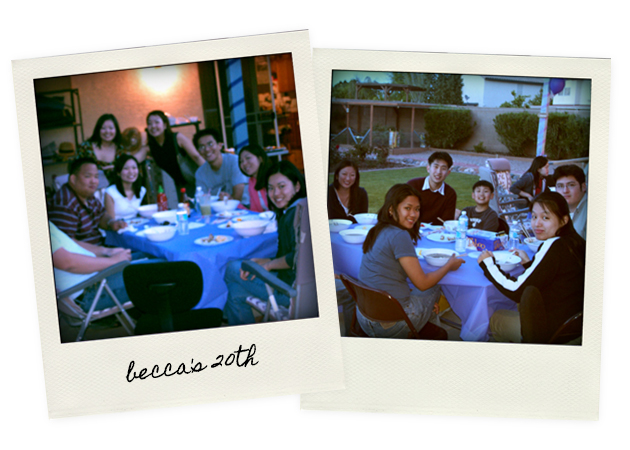
I've been lucky enough to have lived close to my parents or, later, in cities where good pho could still be sought out. But that all changed a year and a half ago, when I moved to a tiny island in the middle of the Caribbean. While there's no shortage of things like sugar cane or other tropical fruits here (some of which also grow in Vietnam), I had to resort to bringing my own rice noodles. And I definitely had to start making my own pho.
My sister, on the other hand, has not come by pho so easily in the places she's lived. Whether it was in the desertlands of Tucson, Arizona, or sub-Siberian Beijing where she lives now, she had long ago prepared for pho emergencies by taking down Dad's notes. And so it is her recipe and notes that are shared below. And it was this recipe that I followed when I finally simmered my first pot of pho broth earlier this year.
What I've found is that my love affair with pho is only deepening as I learn to appreciate the complexity and subtleties of fine pho-making. It’s not until you sit down and learn how to make pho from scratch that you finally understand the whole story of pho. How the smoky sweetness comes from charred onion, the rich mouthfeel of the broth from bones full of marrow and collagen, the clear golden broth color from hours at a bare simmer, and the soft-yet-chewy noodles from flash-boiled, fresh rice noodles.
And when you combine all that with the childhood memories of a mother who’d remember to leave out the scallions and cilantro for a picky eater like me, or a father whose artistic temperament translated into perfectly balanced broth every time, or a family of four who often couldn’t wait for the broth to finish simmering the next day that we’d just drink a bowl of the soup with some meatballs as a midnight snack — well, it’s not hard to understand why I often tell people that if I could have one last meal before I die, I would choose to eat Dad’s pho.
Click through for notes and recipe.
Notes from Julie:
Stock bones. Look for marrow and knuckle bones cut from beef leg bones. The marrow contains fat for flavor (don't worry, it can be skimmed off at the end). And knuckle bones in particular have plenty of cartilage, which creates a rich, gelatinous broth — and is good for you! These days, traditional bone broth is being touted as a superfood because it contains lots of minerals, collagen, and amino acids.
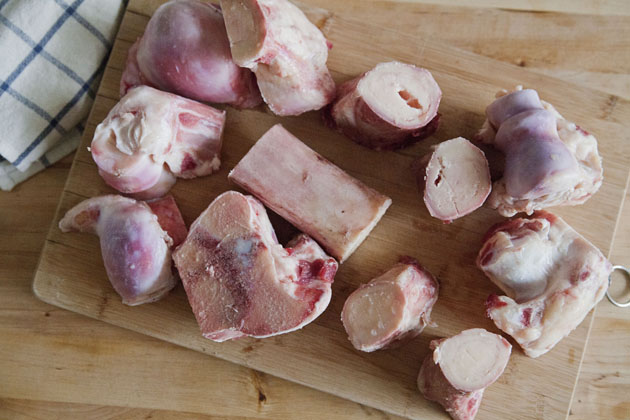
Serving meats.ÂIf, in addition to rare slices of eye of round sirloin, you plan to serve the pho with other cuts of beef (flank, brisket, etc.), those can also simmer in the stock, but only for a few hours, or until they become tender but still retain their flavor. One of the reasons restaurant pho stock is so flavorful is because they serve a wide variety of beef cuts that simmer in the pot throughout the day. For a special treat, I like to use oxtail, which has bones, marrow, fat, and meat — and many believe it contributes the best flavor out of any of the cuts. If you opt to roast bones for the broth (discussed below), you might also consider getting some extra marrow bones to roast and serve at the table.
Parboiling versus roasting. Traditionally, making pho involves first parboiling the bones in order to get rid of all the scum and impurities, which yields a clearer and cleaner-tasting stock. But in recent years, my parents have taken to also roasting the bones for further depth of flavor. Since they told me this, I've also found mention of using roasted bones for pho here and there on the internet. So I decided to do a little experiment to see for myself what the difference is between these methods.
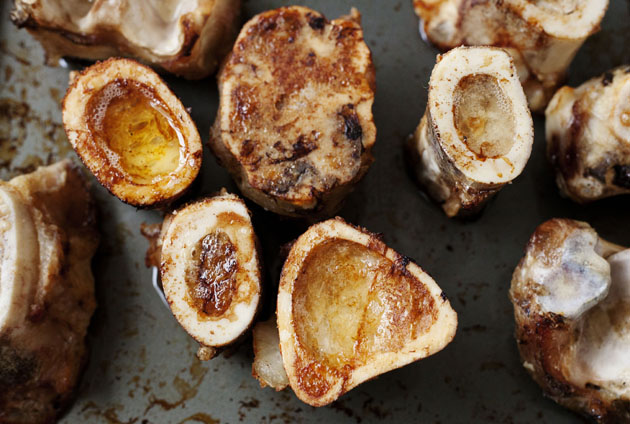
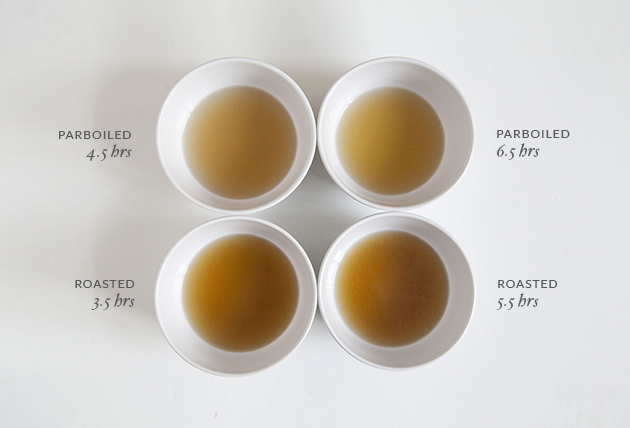
Clarity. The key to a clear stock is to keep the liquid at just the barest of simmers. You only want to see a little bubble every now and then, if not just a shimmer. My parents swear by leaving the pot uncovered, which helps regulate the temperature in order to keep the liquid at the lowest simmer possible. I have yet to try making pho in a slow cooker, mainly because I haven't had one large enough to contain all the bones and stock components, but the idea makes sense. I like the sound of Wandering Chopstick's slow cooker method using oxtail, which is a cut of beef that offers a lot of flavor in a small package. Chicken pho may also be quite doable in a slow cooker.
In addition to maintaining a very low simmer, you also want to leave the pot undisturbed. Don't stir or rummage through to look for things. Keep any meat that will be taken out after a few hours at the top of the pot, so that you don't have to dig for them. It's also best to put the onion, ginger, and garlic in cheesecloth or a fine mesh bag, as these will begin to disintegrate and cloud the broth after cooking for a long time. If you don't have any cheese cloth, keep the onion and garlic at the top of the pot and, and if they start to look like they're disintegrating after hours of simmering, go ahead and take them out.
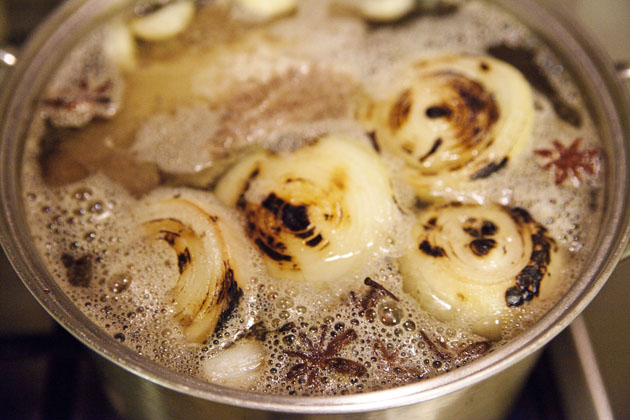
Simmer time. My parents simmer their beef stock for 8 hours or more. They usually do it overnight, getting up a couple times to check on it. I have to admit that I have never had the stamina to make it much past 6 or 7 hours (I make it during the day and let it cool overnight). There is a marked difference in how long the pho broth simmers. The color deepens, the flavor develops more intensity and fullness, and the texture changes. A broth that has simmered longer becomes very gelatinous when cooled, filled with collagen and minerals. The amount of gelatin also contributes to texture and mouthfeel — there's a rich stickiness and viscosity that coats your mouth in a long-simmered broth. And in terms of nutritional value, this article states that beef bone broth should be simmered at least 12 hours and up to 72 hours! That may not be needed for flavor, but I have heard of pho restaurants that never turn off the heat on their broth — they just continue adding more ingredients to that master stock day after day.
Charred aromatics. Do not skip this step! Traditional pho stock requires charred onion and ginger. In Vietnam, these are charred on a charcoal grill, and in Vietnamese American homes this has commonly translated to holding the aromatics over an open flame with a pair of tongs or setting the aromatics directly on an electric burner. This is how I do it, because that's how my parents have always done it. If you have a broiler, that is a good (and probably safer) alternative. My parents also like to char a whole head of garlic cut in half to include in the broth.
Spices. Traditionally, star anise, cloves, and cinnamon are the three key spices used in flavoring pho broth. There are recipes that also use coriander seeds, black cardamom pods, and even fennel seeds. My dad also adds black peppercorn. If you have any of these, feel free to add them. For simplicity, I usually just stick with star anise, cloves, and cinnamon, which I think are the core spices contributing to that recognizable pho flavor. These spices should first be toasted briefly in a dry pan to release their aroma.
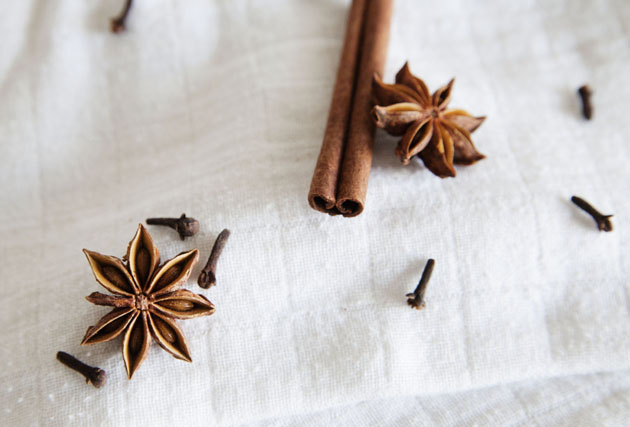
Seasoning. Yellow rock sugar lends a nice, round sweetness to the broth, whereas regular granulated sugar will be harsher and more aggressive. I put the rock sugar in at the beginning so that it has a chance to melt and permeate the broth. But I suggest not seasoning with salt or fish sauce until the very end because you don't have a good idea of how much the stock will reduce during the cooking time.
Noodles. Fresh noodles have a bite that dried noodles just don't, so get freshÂbanh pho noodles if you can (available at Asian grocers).  If using dried noodles, look for a Thai or Vietnamese brand and get the thinnest you can find. I find that soaking the dried noodles in hot water beforehand helps them to cook more evenly. After soaking, they cook very quickly (about 20 seconds) in boiling water and will be able to retain some bite while still being cooked through.
Freezing. Whenever I make pho I always freeze some of the broth for another day. The cooked meat and fresh noodles can also be frozen (freeze the noodles fresh just as they are, before cooking). Of course, dried noodles are easy to keep on hand. You can have some store-bought beef balls ready in the freezer as a quick addition (these are already cooked when you buy them). This way, Â you can still enjoy a hot steaming bowl of homemade pho with very little effort.
Shortcut pho. On days when I do not have any premade broth, I'll put together a very simple pho just by opening up a can of beef broth, tossing in a star anise and a couple cloves, a slice of ginger and a chunk of onion (I don't even char them in this version), and letting all that simmer for a few minutes before throwing in a bundle of quick-cooking bean-thread noodles. I season with a bit of sugar and fish sauce at the end, and then add in a couple beef balls from the freezer and maybe some leafy greens to balance out the meal.
Now, without further ado — the recipe!
Pho Bo (Vietnamese Beef Noodle Soup)
Serves 6â€"8
For the broth:
5 lbs beef marrow bones and knuckle bones
1 lb beef chuck
1 lb combination of any other beef cuts you enjoy eating with pho: for example, flank, brisket, oxtail, book tripe (not honeycomb tripe), tendon, beef balls (these are optional — you can also just serve pho with rare slices of eye of round or sirloin, listed below)
2 medium yellow onions
3-inch piece of ginger, cut lengthwise, lightly bruised
1 head of garlic, loose dried skin removed, cut crosswise through the middle of the entire bulb to expose the cloves inside
5 star anise
10 cloves
1 cinnamon stick, about 3 inches long
1 oz. yellow rock sugar (roughly a 2-inch cube)
5 quarts water, or enough to cover all the ingredients
1 Tbsp kosher salt (less if using regular table salt)
4 Tbsp and 2 tsp fish sauce, added incrementally to taste
To serve:
1.5 lbs thin flat rice noodles (banh pho), fresh if possible or dried if not
1/2 lb eye of round or sirloin (increase to 1 lb if this is the only cut of beef you'll be serving with the noodles)
1/2 yellow onion, sliced paper thin
3 scallions, thinly sliced
1 small bunch cilantro, chopped
Herb plate:
2 cups bean sprouts
1 bunch Thai basil
1 bunch culantro (also known as sawtooth herb or Vietnamese coriander)
Thai bird chilies
1 lime, cut into wedges
Condiments:
Sriracha sauce
hoisin sauce
Directions
1. PARBOIL: Put all of the bones into a stockpot of 10- to 12-quart capacity. Fill the pot with enough water to just cover all the bones, leaving at least 1 inch at the top to allow room for boiling. Heat the pot on high until the water boils and let it continue to boil aggressively for 5 minutes so that all the scum and impurities can be released and skimmed off. When it looks like no more scum is being released, turn off the heat. Pour the contents of the pot into a colander or directly into a clean sink that is lined with a strainer to catch solids. Rinse the bones until they are clean of blood, scum, and impurities. Be careful not to lose any marrow in the process.
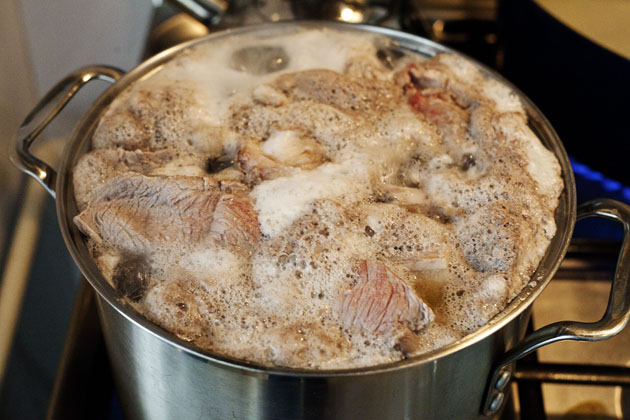
[ROAST (optional step):ÂParboiling the bones is sufficient for a clean, pure, traditional pho broth (which I actually prefer). But for an interesting twist that will yield a beef broth with deeper flavor in a shorter amount of time, roasting can be undertaken either instead of parboiling or even in addition to parboiling. First, rinse the bones of any loose bits and then set them in a roasting pan or a sheet pan with a lip to catch the fat that will be released. The marrow bones should face up so that the marrow remains intact. Roast on 400°F for about 45 minutes, turning halfway through. The bones should turn a golden brown color. If this doesn't happen, turn on the broiler for a few minutes at the end to allow the bones to brown, watching carefully to make sure they don't burn. If they brown too quickly, turn down the heat a bit.]
2. CHAR the onion, ginger, and garlic either by holding them with metal tongs over an open flame or setting them directly on an electric burner. Alternatively, you can put them under a broiler. Remove once they take on some color and char, but before they become burned. Put the charred onion, ginger, and garlic into a fine mesh bag or in some cheesecloth that can be tied with string. If you do not have either of these, make sure the onion and garlic are at the very top of the stockpot during simmering time so that you can remove them if they begin to disintegrate into the stock.
3. TOAST: In a small dry pan, toast the star anise, cloves, and cinnamon on low heat for a few minutes, or until they begin to release their aroma. Add the toasted spices into the fine mesh bag or cheesecloth and tie shut with string. You can also use a tea strainer ball.
4. SIMMER: Put the parboiled and/or roasted bones into a clean stockpot. (If using the same stockpot as in Step 1, be sure to clean it well before returning the bones to the pot or else the remaining bits will cloud the stock.) Add the chuck for flavor and any flank, brisket, oxtail, or tendon you plan to serve (see below for instructions for tripe and beef balls). Add the charred onion, ginger, garlic, toasted spices, and the rock sugar. Fill the pot with 5 quarts of water, or until all the ingredients are covered. Turn the heat on high, but keep a close eye on the pot to prevent the water from reaching a full boil. Just before the water reaches boiling (small bubbles will begin to rise), turn the heat to the lowest setting to maintain a very low simmer. If you're not already using the smallest burner on your stovetop, then move the pot there now to keep the heat at a minimum. You want as little movement in the water as possible. Keep the broth at a very low simmer for 6-8 hours, skimming regularly for any scum and impurities that rise to the surface. If you are not using a mesh bag or cheesecloth to hold the onion and garlic, check to make sure that they don't start to disintegrate and cloud the stock after several hours — if so, go ahead and remove them.
5. PREPARE MEATS: For the eye of round or sirloin, which will be served rare, put the whole raw piece of meat in the freezer for about 30 minutes to let it harden a bit. This makes it easier to slice thinly. Then take the meat out and slice across the grain as thinly as possible. Refrigerate the sliced meat until the pho is ready to serve. If cooking flank, brisket, or oxtail, check the doneness of these meats after 2-3 hours of simmering in the stock (depending on how larget the pieces of oxtail, that cut may take longer). When tender, take these meats out (but make sure to leave the chuck in) and let them rest for at least 15 minutes. Slice the flank and brisket across the grain. Leave small pieces of oxtail as is or, if large, they can also be roughly shred with a fork. Let the meat cool, then refrigerate until ready to serve. Tendon will take longer to cook — about 4 hours or up to 6, depending on how soft you like your tendon (pho restaurants serve it slightly crunchy, which it will be after about 4 hours, but my family likes it more soft and gelatinous, which takes a few hours more). Remove the tendon when cooked to the desired doneness. If slightly crunchy, serve it thinly sliced crosswise. If soft and gelatinous, cut into 1- to 2-inch chunks. Book tripe and beef balls should already by cooked or par-cooked when you purchase them. Wash the tripe and slice into strips, so that each piece has a set of fringes attached. The beef balls can be sliced in half or quarters if preferred. Wait until just before serving to add the tripe and beef balls to the broth in order to heat them through. The tripe should be crunchy — be careful not to overcook or it will become too chewy.
6. STRAIN: After the stock has simmered 6-8 hours, remove all of the stock ingredients (bones, meat, aromatics, and spices). The beef chuck can be discarded or reserved for another use. Strain the broth through a fine-mesh sieve lined with cheesecloth and return to pot.
7. SEASON: Â Season the broth with salt and fish sauce, starting in small increments and tasting as you go. The broth should end up on the saltier side and will balance out when served with the noodles and other ingredients. I usually end up with about 4 quarts of broth after simmering and find that the listed amount of salt and fish sauce is about what's needed for my tastes. But every pot of broth turns out differently depending on many factors, and you may end up with more or less liquid after simmering, so season incrementally and according to your tastes. You can also add more sugar if you like your pho on the sweeter side.
8. SKIM: After seasoning, the broth can be either served right away or allowed to cool at room temperature. If serving right away, the fat can be skimmed off with a spoon or skimmer or by using a fat separator (though a little bit of fat lends flavor!). If serving later, store the cooled broth in the fridge to let the fat solidify, after which it can be lifted off and discarded.
9. NOODLES: Always cook the noodles in a separate pot of water, never in the stock itself. If cooking the noodles beforehand (that is, before your broth is ready), always undercook them slightly since they will need to be reheated before serving. If using dried noodles, first soak them in hot water for 30 minutes. Then, add the soaked noodles to a pot of boiling water and cook for about 20 seconds. Drain and rinse under cold water. If using fresh noodles, loosen them first under cold water before adding them into a pot of boiling water. Cook for about 20 seconds or until just al dente. Drain and rinse under cold water. To reheat just before serving, place individual portions of noodles in a sieve and submerge the sieve into boiling water for a few seconds, just until the noodles come loose.
10. ASSEMBLE: When ready to serve, distribute the cooked noodles among individual bowls. Lay thin slices of raw sirloin or eye of round on top of the noodles. Reheat any meats previously removed from the stock (from step 5) by putting them in a fine-mesh sieve and submerging this into the hot broth. Arrange these other meats on top of the cooked noodles. If serving any roasted marrow bones, add to the bowl or serve it on the side with some extra broth. Top the bowl off with paper-thin slices of onion and a sprinkling of chopped scallions and cilantro. Assemble each bowl in the same way.
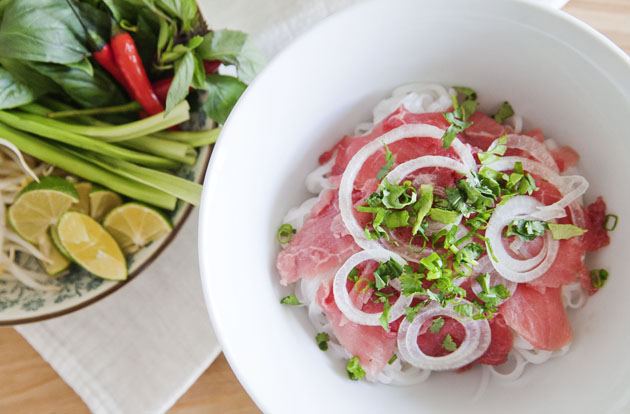
11. SERVE: Bring the broth up to a very gentle simmer. Ladle the hot broth over the contents of each bowl. I like to be generous with the broth, so that all the ingredients are submerged and the scallions and cilantro are floating in liquid. The hot liquid should just cook the rare slices of beef. Serve the noodle soup with the herb plate and condiments on the side, with small dipping plates for each person.
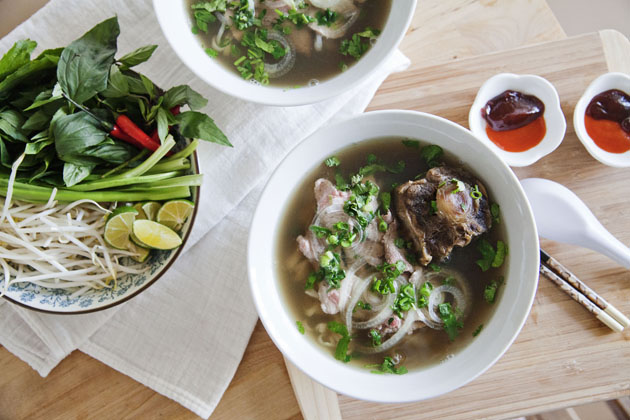
We asked you to share what's in your pho earlier this week. Now you know exactly what's in ours! When we eat out, I (Julie) normally get a pho dac biet (combination special, which includes all the cuts). I add all the garnishes — bean sprouts, Thai basil, culantro, fresh chili peppers (jalapeno in the US), and lime. Becca gets pho tai gau (rare beef and fatty brisket), with the rare beef on the side to add herself (you only get this option at the hard-core pho places, like in California!). She also puts in a special request for no scallions or cilantro, which may or may not get fulfilled. She adds just basil and lots of lime. Most important of all for both of us, we squirt Sriracha and hoisin sauce always onto a dipping plate (or another soup spoon if no dipping plates are available). We never add this straight into our bowl because we believe it masks all the nuanced flavors of a good pho broth. And, lastly, I like to eat my pho by creating little "pho bundles" in my soup spoon and then dunking it into the broth. This way, I get a bit of everything in one bite, including the flavorful broth. If you're slurp-averse, this also has the benefit of allowing you to eat pho in polite company. But, really, I just do this to get broth in every bite. :)
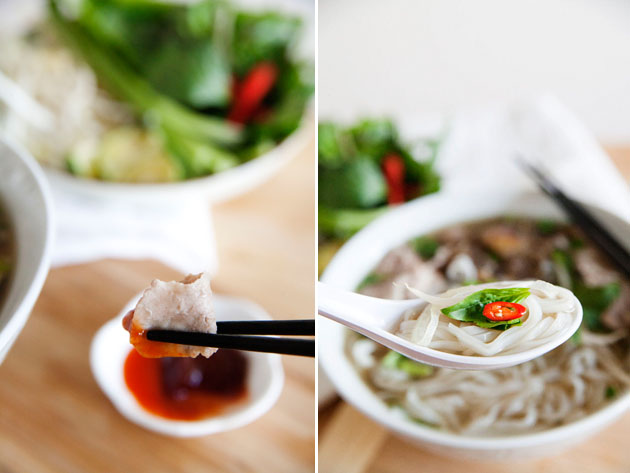

Some other great pho recipes online:
- Epicurious recipe by Mai Pham, author ofÂPleasures of the Vietnamese Table. I find this one to be closest to the way my family makes pho.
- Viet World Kitchen's recipe by Andrea Nguyen, author ofÂInto the Vietnamese Kitchen and authority on Vietnamese cuisine. Andrea also has delved into the controversial history of pho and has a great set of tips on how to make it at home.
-Â Gastronomy's family recipe. I love the story of how her grandma makes it.
– Wandering Chopsticks' recipes for pho bo and slow cooker oxtail pho, which I am eager to try soon.
pritchardsysion1963.blogspot.com
Source: http://www.meatlovessalt.com/2013/04/dads-pho-bo-vietnamese-beef-noodle-soup/
0 Response to "How to Make â€å“brownã¢â‚¬â Beef Bone Stock"
ارسال یک نظر